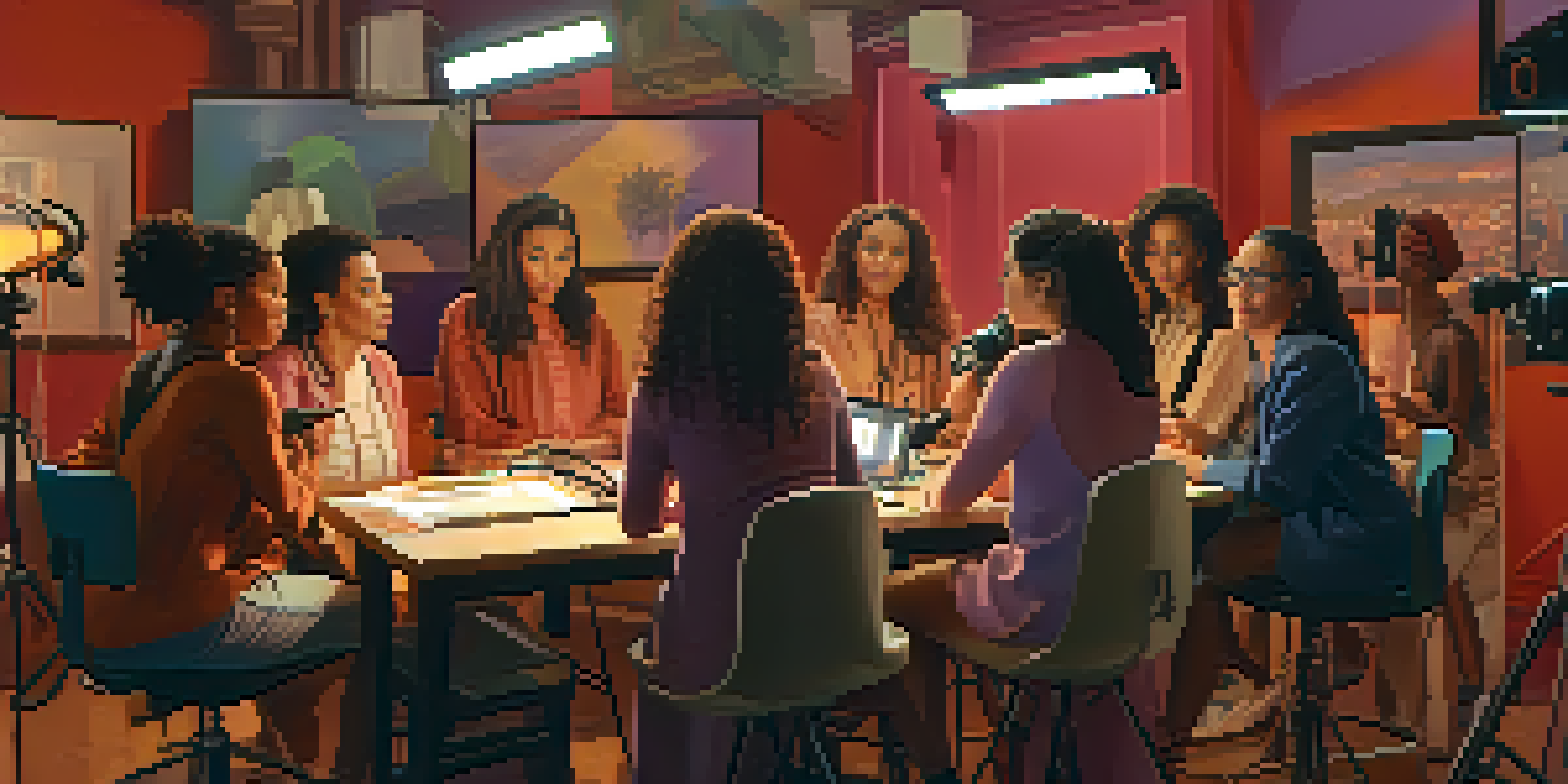Feminist Film Theory: Analyzing Gender Representation in Films

Introduction to Feminist Film Theory and Its Importance
Feminist film theory emerged in the 1970s, aiming to analyze how films represent women and their experiences. It critiques the male gaze, a term coined by Laura Mulvey, which refers to the way visual arts are structured around a masculine viewer. Understanding this theory is crucial because it sheds light on the power dynamics in cinema and how they shape societal perceptions of gender.
The camera relays the social and cultural prejudices of the society that created it, and that is what the male gaze is all about.
At its core, feminist film theory challenges traditional narratives that often marginalize women's voices. It invites viewers to question who is telling the story and how it impacts their understanding of gender roles. Through this lens, films are not just entertainment; they are reflections of cultural attitudes towards gender, which can either reinforce or challenge stereotypes.
By engaging with feminist film theory, audiences can develop a more critical eye when watching films. This awareness allows for a deeper appreciation of the complexities of gender representation, encouraging both creators and viewers to strive for more equitable portrayals on screen.
Key Concepts: The Male Gaze and Objectification
The male gaze is a foundational concept in feminist film theory, describing how films often depict women from a masculine perspective. This perspective positions women as objects of desire rather than as autonomous individuals with their own narratives. For example, in many classic films, female characters are primarily defined by their relationships with male protagonists, reducing their roles to mere accessories.

Objectification in cinema goes beyond just the physical portrayal of women; it also influences how stories are constructed. When women are portrayed primarily as objects for male pleasure, it sends a message about their worth being tied to their appearance. This can have real-world implications, affecting how society views and treats women in various contexts, from personal relationships to professional environments.
Feminist Film Theory Unpacked
This theory critiques how films often depict women through a male lens, highlighting the importance of understanding gender dynamics in cinema.
Understanding the male gaze and objectification allows viewers to recognize patterns in storytelling and character development. By critiquing these portrayals, audiences can advocate for more nuanced and empowered representations of women, promoting stories that reflect their complexity and strength.
The Role of Women Behind the Camera
Feminist film theory not only analyzes on-screen representations but also emphasizes the importance of women in filmmaking roles. Female directors, writers, and producers bring unique perspectives that can challenge traditional narratives. When women are involved in the creative process, it often leads to richer, more authentic portrayals of female characters.
Feminism is not just about women; it's about changing the power structure that affects all of us.
For instance, films directed by women, such as 'The Piano' by Jane Campion or 'Lady Bird' by Greta Gerwig, often explore complex themes of identity and agency. These films tend to prioritize women's experiences and showcase a range of emotions and challenges that resonate with audiences. By highlighting women’s stories, these filmmakers contribute to a broader understanding of gender.
The presence of women behind the camera is pivotal in changing the landscape of cinema. More female filmmakers are essential not only for representation but also for challenging the status quo and expanding the types of stories that get told. This shift encourages a more inclusive cinematic world where diverse voices are heard and valued.
Intersectionality in Feminist Film Theory
Intersectionality is a key concept within feminist film theory that recognizes the interconnectedness of various social identities, such as race, class, and sexuality. This approach emphasizes that women's experiences are not monolithic; they vary greatly depending on their backgrounds. For instance, a film that focuses solely on white, middle-class women may overlook the unique challenges faced by women of color or those from different socioeconomic statuses.
By incorporating intersectionality, feminist film theory encourages a more comprehensive analysis of gender representation in film. It invites viewers to consider how different identities intersect and shape a character's narrative. This broader perspective can lead to more inclusive storytelling that reflects the diversity of women's experiences.
Women Behind the Camera Matter
The involvement of female filmmakers leads to richer and more authentic portrayals of women's experiences in film.
Films like 'Moonlight' and 'The Joy Luck Club' exemplify intersectional narratives, showcasing how race, culture, and gender intersect. These stories not only enrich the cinematic landscape but also foster empathy and understanding among audiences, making it clear that the fight for gender equality must consider a variety of perspectives.
Challenging Stereotypes: Feminism in Modern Cinema
In recent years, there has been a noticeable shift in how films depict female characters, moving away from traditional stereotypes towards more authentic representations. This change is partly due to the influence of feminist film theory, which has inspired filmmakers to create complex, multidimensional female characters. Movies like 'Wonder Woman' and 'Hidden Figures' showcase women in empowered roles, challenging the notion that they must conform to outdated archetypes.
Modern cinema increasingly reflects diverse narratives that resonate with contemporary audiences. These films often highlight themes of resilience, agency, and friendship among women, making them relatable and inspiring. The success of such films indicates a growing demand for content that prioritizes women's stories and experiences.
By challenging stereotypes, modern cinema plays a crucial role in reshaping societal attitudes towards gender. As more films embrace feminist themes, they contribute to a cultural shift that values equality and representation, paving the way for future generations of female filmmakers and audiences alike.
The Impact of Audience Reception on Gender Representation
Audience reception plays a vital role in the evolution of gender representation in film. As viewers become more aware of feminist film theory, they begin to demand more equitable and diverse portrayals of women. This shift in expectations can influence box office success, as films that embrace these values are more likely to attract audiences who seek authentic storytelling.
Social media has amplified this impact, allowing viewers to voice their opinions and hold filmmakers accountable. Online discussions and critiques can create a ripple effect, encouraging studios to consider audience feedback when developing new projects. For example, the backlash against stereotypical portrayals often leads to changes in how characters are written and presented.
Intersectionality Enriches Narratives
Incorporating intersectionality in feminist film theory allows for a deeper understanding of diverse women's experiences in storytelling.
By participating in these conversations, audiences not only contribute to the dialogue around gender representation but also shape the future of cinema. Their engagement helps foster an environment where diverse voices are prioritized, ultimately leading to a richer and more inclusive cinematic landscape.
Conclusion: The Future of Feminist Film Theory
As we look to the future, feminist film theory remains a crucial framework for analyzing gender representation in cinema. Its ongoing evolution reflects the changing dynamics of society and the increasing recognition of women's voices in storytelling. With the rise of female filmmakers and a growing emphasis on intersectionality, the landscape of film is expanding in exciting ways.
The continued exploration of feminist themes in film not only enriches the medium but also encourages critical conversations about gender and power. By advocating for diverse and authentic representations, feminist film theory can help dismantle harmful stereotypes and promote equality across the industry.

Ultimately, the future of feminist film theory is bright, with the potential to inspire future generations of filmmakers and audiences. As more stories emerge that reflect the complexities of women's lives, we can look forward to a more inclusive and equitable cinematic world.